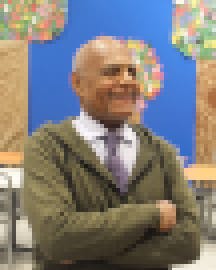
Civil rights leader and education pioneer Bob Moses (1935-2021), who died in late July, always looked at his evolving mission through the lens of citizenship and what educational processes were needed to achieve and enjoy its blessings.
His starting point was the preamble to the U.S. Constitution and, oddly enough, an effort by President Ulysses S. Grant, responding to the social revolution of Reconstruction, to make quality education a constitutional right. The Republican Congress was tiring of Reconstruction and did not go along; Grant’s objective has yet to be fulfilled. If we are to “achieve our country,” as Moses echoed James Baldwin, we must claim for all Americans the constitutional right to a quality education.
Bob Moses was inspired and mentored by Ella Baker, 32 years older, who had mastered the art of community organizing over half a century before she midwifed the birth of the Student Nonviolent Coordinating Committee in 1960. She saw organizers as teachers who committed not to build up their own leadership but to develop leadership in others. She and Moses believed that everyone had leadership potential but it must be taught. Thus they created various forms of citizenship education and spread it widely. Because they centered leadership in the community—not in top-down charisma but from bottom-up, shared leadership among equals—they called it group-centered leadership. Participants were responsible to each other, holding each other accountable to the group’s values and mission. Group-centered leadership and citizenship education, aimed at securing voting rights for African Americans, were grounded in the community and in family support, both of these vital in the rural South.

More than a decade after the 1965 Voting Rights Act, Moses realized that the next frontier was economic justice, and that fluency in math and science was the springboard for peoples of color and low-income whites to be full citizens, fully enfranchised—the civil rights issue of the 21st century. While Moses was completing his Ph.D. in the philosophy of mathematics at Harvard with his four kids starting school, he grasped that in order for math literacy, algebra in particular, to be accessible to disadvantaged children, teachers-as-organizers would need to teach it like he and SNCC colleagues had taught community organizing—as experiential learning in one’s community.
Remarkably, Moses translated his dissertation supervisor’s philosophy of “set theory” into a process of teaching algebra through students’ active participation and empowerment. (Sets can perhaps be seen as the mathematical equivalent of human groups.) For example, whether in Boston, the Mississippi Delta, or Miami, students explored algebra problems by mapping bus or subway routes and “solving” the problem by reaching their destination, as if in a scavenger hunt. Self-directed students learned algebra by teaching and learning from their pals in solving real-life problems. These strategies developed into the Algebra Project, which, with support from a MacArthur “genius” grant, took off exponentially (as it were). Though still not mainstream, over the past 40 years the Algebra Project has opened doors and vistas for hundreds of thousands of middle and high school students North, South, East, and West.
In the Algebra Project, students move through five steps: direct experience, pictorial representation, intuitive expression, structured expression, and symbolic representation. Starting with the kids’ shared experiences, “we get them to reflect on these drawing on their common culture,” Moses wrote in “Radical Equations,” “then to form abstract conceptualizations out of their reflections, and then to apply the abstraction back on their experience.” The students learn about the social construction of mathematics, created by “people working together and depending on one another. Interaction, cooperation, and group communication” are crucial, like during the Mississippi freedom movement. Real democracy from the bottom up.
Moses knew that the road to economic justice would require systemic transformation, but that the organized demand must come from the grassroots, especially from disadvantaged youth themselves. Allied with the Algebra Project, Moses’ children and their coworkers around the country launched the Young Peoples Project (YPP), which has supported a host of experiential learning activities, inside and outside of schools, including protest and direct action when needed. The YPP groups are run democratically by young people, who have linked up with other YPP groups and adult activists to push for broader reform—not incremental “reformist” reform, but true transformation. As they push for statewide and national curriculum reform, always grounded in local community needs, aligning with school boards and teachers’ unions or bypassing them, they keep their eyes on the prize: a constitutional amendment establishing quality education (pre-K through college) as a constitutional right. The grueling process of congressional passage and state-by-state ratification will itself offer a vast social laboratory of experiential learning, with the YPP and its allies front and center.
The amendment drive will no doubt raise the consciousness of Americans about systemic learning disparities and inequities and the need for creative, holistic solutions that serve every citizen and aspiring citizen. But as we’ve learned painfully from the post-Civil War 13th, 14th, and 15th amendments, constitutional reforms must be implemented by congressional action and grassroots activism (these two often in conflict). Complex questions will need to be resolved, most importantly: what constitutes quality education, how to be implemented in low-income districts with low tax funding, how applied to higher education, how fairly measured, how accountable to local people, how sustained over time?
Bob Moses always took the long view of social transformation, devoting himself to short-term growth at the group and individual level—teaching middle school and high school math for many years in Jackson, Mississippi, and elsewhere—but knowing that universal fluency in math and science will take a few generations, with or without the constitutional amendment. He was known for his powerful eyes. So metaphorically speaking, he saw with one eye the real person right here, and with the other eye that person or group of people transformed—newly empowered citizens committed to democratizing education, making it a force of liberation for all peoples.

